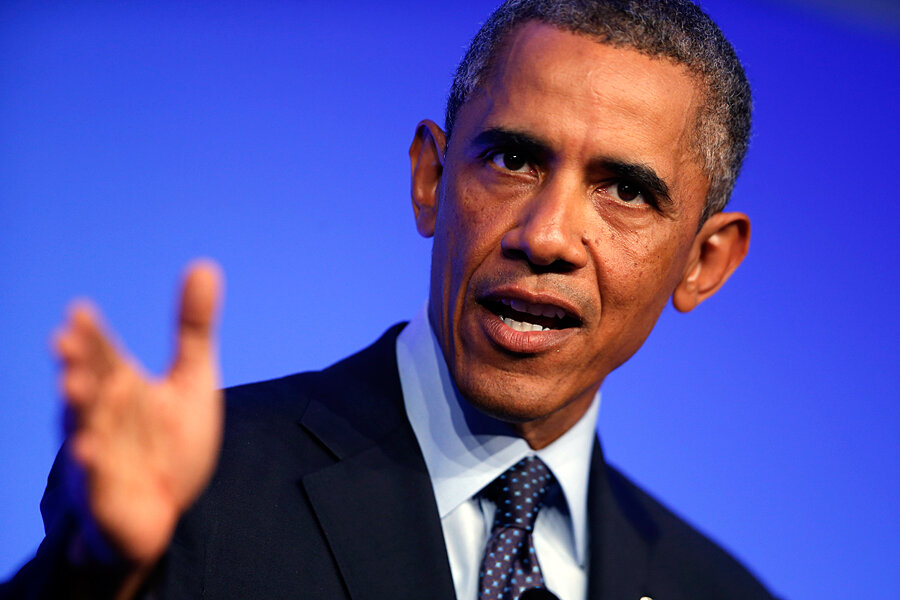How Obama plans to ace his big speech on ISIS
Loading...
| Washington
President Obama’s speech Wednesday on the growing threat from Islamic State militants in Iraq and Syria represents a major test of his leadership.
It’s being billed as an address to the nation, but it will reach far beyond that. Mr. Obama will be speaking foremost to the American people –Democrats, Republicans, and independents – in the heat of the midterm campaign. And it comes at a time of heightened sensitivity to terrorism, the eve of the 13th anniversary of the 9/11 attacks, and the second anniversary of the attack on the US mission in Benghazi, Libya.
Congress will be another key audience. Obama is meeting Tuesday with the four top members of Congress – the Republican and Democratic leaders of each house – both to hear their views and to give them an advance taste of what he will say. But when he delivers his remarks to the public, Obama will also be looking for buy-in from rank-and-file members of Congress as he announces his strategy for dealing with Islamic State, the Sunni group also known as ISIS or ISIL.
In addition, administration officials plan to hold briefings for all members of Congress Wednesday and Thursday.
“The president is interested in their buy-in, is interested in a congressional debate, and is interested in consulting closely with the leaders in Congress,” White House press secretary Josh Earnest said Monday. Obama wants Congress to “feel like the partners that they actually are, as the elected representatives of the American people.”
Also important will be the president’s international audience – the nations already committed to helping the US take on ISIS, the regional allies he hopes to attract, and nonstate actors in the region, including ISIS itself, which controls parts of Syria and Iraq.
“It seems to me, you’re playing the inside game and the outside game,” says Democratic communications strategist Peter Fenn. “It’s a domestic audience, but it’s also an international audience.”
Obama’s goal, says Mr. Fenn, will be to explain “exactly what the threat is, what the policy is, what the short-term strategy is, and what he has in mind long term.”
In an interview that aired Sunday on NBC’s “Meet the Press,” Obama outlined his goals for the speech.
“What I'm going to be asking the American people to understand is, No. 1, this is a serious threat,” Obama said. “No. 2, we have the capacity to deal with it.”
The president also said he will not deploy US ground troops.
“This is not the equivalent of the Iraq war,” Obama said. “What this is is similar to the kinds of counterterrorism campaigns that we've been engaging in consistently over the last five, six, seven years.”
And he will not go it alone. Obama said he wants a congressional vote, though he made clear that he believes he already has the authority to carry out his plan without one. On the international front, Secretary of State John Kerry is recruiting Saudi Arabia, Jordan, Turkey, and the United Arab Emirates to help.
Beyond the substance of Obama’s speech Wednesday, the “optics” – including tone and body language – will be important as well. Obama has been criticized of late for not displaying the anger and passion that might have been called for after videos were released by ISIS showing two American journalists being beheaded.
Obama also took grief for playing golf right after he stepped out to condemn the first beheading. He was on vacation on Martha’s Vineyard at the time, but the media reviews were still unforgiving.
“I should've anticipated the optics,” Obama told Chuck Todd, the new host of “Meet the Press.” “You know, that's part of the job.”
Obama said he thinks people who know him – including the press – know that he cares deeply. “But part of his job is also the theater of it,” he said. “It’s not something that always comes naturally to me.”
The “theater” of his address on Wednesday will also matter. The time and place have yet to be announced, but there have been news reports that he will speak during the day Wednesday, not in the evening, which may somewhat lower expectations.
Despite Obama’s low job approval ratings – averaging 42 percent – he can still expect a “rally around the flag kind of sentiment, especially with these beheadings,” says Bruce Buchanan, a presidential scholar at the University of Texas at Austin. “So he’s got that as a peg upon which to locate these requests for attention and support, independent of his domestic standing.”
Obama’s task is twofold, says Mr. Buchanan. First, the president has to explain the nature of the ISIS threat and his strategy for halting it. Once that’s done, he’s in a position to ask the public for support, and to be patient for the reported three-year implementation.
But “he can’t seem to be the aloof professor,” says Buchanan. “He will need to show conviction and energy.”








